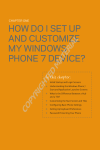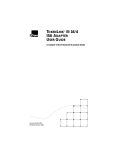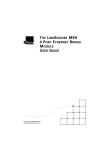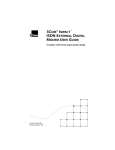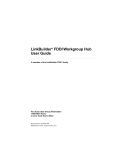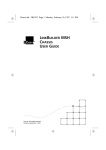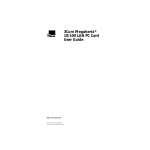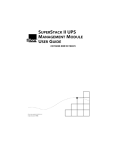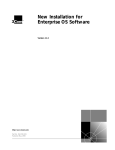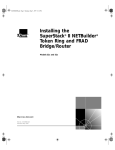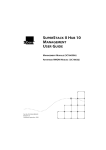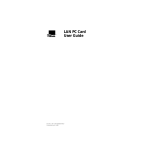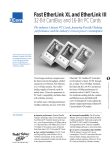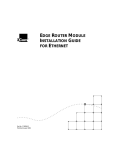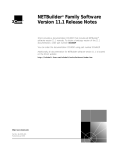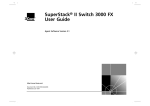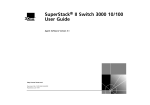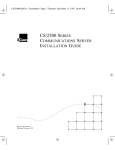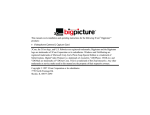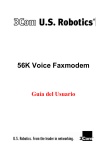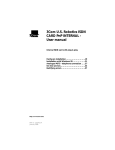Download 3Com NETBuilder II Owner's Manual
Transcript
NETBuilder II® HSSI Module Installation Guide A member of the NETBuilder® family THE PRESIDENT S ENVIRONMENT AND CONSERVATION CHALLENGE AWARD 1992 For 3Com User Group Information 1-800-NET-3Com or your local 3Com office Manual Part No. 09-0489-000 Published January, 1994. Printed in the U.S.A. 3Com Corporation 5400 Bayfront Plaza Santa Clara California 95052-8145 © 3Com Corporation, 1994. All rights reserved. No part of this manual may be reproduced in any form or by any means or used to make any derivative work (such as translation, transformation, or adaptation) without permission from 3Com Corporation. 3Com Corporation reserves the right to revise this publication and to make changes in content from time to time without obligation on the part of 3Com Corporation to provide notification of such revision or change. 3Com Corporation provides this manual without warranty of any kind, either implied or expressed, including, but not limited to, the implied warranties of merchantability and fitness for a particular purpose. 3Com may make improvements or changes in the product(s) and/or the program(s) described in this manual at any time. United States Government Legends: If you are a government agency, then this documentation and the software described herein are provided to you subject to the following restricted rights: For units of the Department of Defense: Restricted Rights Legend: Use, duplication or disclosure by the Government is subject to restrictions as set forth in subparagraph (c)(1)(ii) of the Rights in Technical Data and Computer Software Clause at 48 C.F.R. 52.227- 7013. 3Com Corporation, 5400 Bayfront Plaza, Santa Clara, California 95052-8145. For civilian agencies: Restricted Rights Legends: Use, reproduction or disclosure is subject to restrictions set forth in subparagraph (a) through (d) of the Commercial Computer Software - Restricted Rights clause 48 C.F.R. 52.227-19 and the limitations set forth in 3Com’s standard commercial agreement for the software. Unpublished rights reserved under the copyright laws of the United States. 3ComFacts, Ask 3Com, CardBoard, and CardFacts are service marks of 3Com Corporation. NETBuilder and NETBuilder II are registered trademarks of 3Com Corporation. Boundary Routing is a trademark of 3Com Corporation. CompuServe is a service mark of CompuServe, Inc. Other trademarks belong to their respective owners. Manual written by Jennifer Rhoades. Edited by Chris Dresden. Technical illustration by Paul Naas and Deb Knodel. Production by Ramona Boersma. ii Before You Begin This guide describes how to install, cable, maintain, and troubleshoot the High-Speed Serial Interface (HSSI) module for the NETBuilder II® base system. The information in this guide applies to the NETBuilder II 4-slot chassis and the NETBuilder II 8-slot chassis. For more information about the NETBuilder II base system installation, refer to the NETBuilder II Base System Installation Guide. This guide is intended for the system administrator, network equipment installer, or network manager who is responsible for installing and managing the network hardware. It assumes a working knowledge of network operations, but it does not assume prior knowledge of 3Com internetworking equipment. NOTE: If the information in the release note shipped with your software differs from the information in this guide, follow the release note. How to Use This Guide The following list shows where to find specific information. Refer to the documentation roadmap in the front of this manual for information on related manuals. If you are looking for: Turn to: Installation procedure Chapter 1 Troubleshooting and maintenance information Chapter 2 Description of the HSSI module components Appendix A Technical support information Appendix B Conventions “Enter” vs. “Type” When the word “enter” is used in this manual, it means type something, then press the Return key. Do not press the Return key when an instruction simply says “type.” Text represented as screen display This typeface is used to represent displays that appear on your terminal screen and commands that you enter, for example: setd !3 -path cl = e Bold vs. plain text in procedures Bold text summarizes the task you must perform. Plain text provides additional information, for example: 3. Assign a name to port 1. Use a name that is easy to remember. v Keys When specific keys are referred to in the text, they are called out by their labels, such as “the Return key” or “the Escape key,” or they may be shown as [Return] or [Esc]. If two or more keys are to be pressed simultaneously, the keys are linked with a plus sign (+), for example: Press [Ctrl]+[Alt]+[Del]. Italics Italics are used to denote new terms or emphasis. Special Messages A special format indicates notes, cautions, and warnings. These messages are defined as follows. NOTE: Notes call attention to important features or instructions. CAUTION: Cautions contain directions that you must follow to avoid immediate system damage or loss of data. WARNING: Warnings contain directions that you must follow for your personal safety. Follow all instructions carefully. vi Chapter 1 Installation This chapter describes how to install the HSSI module into the NETBuilder II ® base system. The HSSI module provides a single serial interface for a WAN connection in the NETBuilder II base system. It supports transmission rates up to OC1, including E3, T3, and sub-rates. NOTE: The HSSI module must be used with NETBuilder II HSSI and Single-Mode FDDI Software 6.2. For information about the software, see the NETBuilder II HSSI and SingleMode FDDI Software 6.2 Release Notes. For information about the HSSI module components, refer to Appendix A, “HSSI Module Components.” Before Installing the HSSI Module Before you install the HSSI module into the NETBuilder II base system, follow these steps: 1. Observe appropriate ESD precautions. Electrostatic discharge (ESD) can damage circuit board components. Failures resulting from ESD may not be covered under your warranty. To prevent this, follow these handling procedures: ■ ■ ■ ■ Keep the HSSI module in its antistatic shielded bag until you are ready to install it. Do not touch pins, leads, or solder connections on the board. Handle the board by the edges only. Store or ship the HSSI module in static-protective packaging. Observe proper grounding techniques when handling the HSSI module: Use a foot strap and grounded mat, or wear a grounded static discharge wrist strap. 2. Inspect the HSSI module for shipping damage. If you find any damage, contact the shipping company to file a report. If the assembly must be returned to your network supplier, ship it in its original shipping carton. If the original carton was damaged in shipment, repack the system in a carton that provides equivalent protection. 1-2 Installation Before Installing the HSSI Module 3. Verify that you have received all the contents. When you purchase the HSSI module, you receive the following: ■ ■ HSSI module NETBuilder II HSSI Module Installation Guide If an item is missing from an undamaged carton, contact your network supplier to secure a replacement. ule I Mod ®I HSS I e r uildetion Guid mily NETB der fa lla TBuil Insta e NE mber A me of th ation Inform roup e ser G om U -3Com om offic .S.A. l 3C NET For 3C the U 0 1-800-your loca 489-00Printed in -0 or No. 09 1994. l Part nuary, Manuablished Ja Pu 4. Write down the serial number and the MAC address from the label on the component side of the HSSI module on the following line: Serial number label Serial number example: S/N:1BK12345 MAC address example: 0800021A4B5C You will need this information if you have to contact your network supplier. The MAC address is also encoded in the HSSI module’s EEPROM. Use the procedure in Appendix B, “Displaying the MAC Address,” to display the MAC address encoded in the EEPROM. Installation 1-3 Installing the HSSI Module Installing the HSSI Module Use this procedure to install the HSSI module into the NETBuilder II base system. You will need a small flathead screwdriver. NOTE: There are two versions of the NETBuilder II 4-slot and 8-slot chassis. The older, singlewide versions of the NETBuilder II 4-slot and 8-slot chassis have two flipper ejectors for each module. The newer, dual-wide versions have one flipper ejector for each module, except for the top slot which is reserved for the CEC module. When the term “dual-wide NETBuilder II chassis” is used in this manual, it refers to a chassis with only one flipper ejector per module. 1. Select an I/O slot in which to install the HSSI module. You can install the module in any available I/O slot in the rear of the NETBuilder II base system. The top slot is designated for the CEC module only. 2. Remove the blanking plate from the I/O slot you have selected for the HSSI module. CEC slot I/O slots (8) 1 8 2 7 3 6 4 5 1 2 Loosen captive screws (with screwdriver if necessary) Push flipper ejector(s) open 3 Slide blanking plate out of rear panel CAUTION: Only remove the blanking plate from an I/O slot that will house an I/O module. All unused I/O slots require blanking plate covers to maintain proper cooling of the unit and regulatory compliance. Failure to cover open slots can result in overheating of the NETBuilder II base system and voiding of the warranty. 1-4 Installation Installing the HSSI Module 3. Insert the HSSI module into an uncovered I/O slot. Make sure the flipper ejector(s) are in an open position. Flipper open Flipper closed With the connector end toward the backplane and the board facing up (check that the labels on the connector/LED panel are right side up), grasp the left and right sides of the panel and fit the board into the I/O slot opening along the guide rails. 4. Lock the board in the slot. For the dual-wide NETBuilder II chassis, use your thumbs to push the board all the way into the slot. As you slide the board into the slot, the flipper ejector engages itself. For single-wide NETBuilder II chassis, push the flipper ejector closed. 1 8 2 7 3 6 4 5 ® STATUS Push board into slot 5. Check that the connector/LED panel of the newly inserted module is flush with the NETBuilder II chassis. To verify that the board is seated correctly, check that it is aligned with the connector/LED panel of an installed module. 6. Hand tighten the captive screws. Do not use a screwdriver. A solid connection of the connector/LED panel to the chassis is required for proper operation. Do not use the screws to force the board into place. Installation 1-5 Installing the HSSI Module Cabling the HSSI Module for Network Connection A SCSI-type cable connects the HSSI Module DTE connector to a Data Service Unit (DSU). Table 1-1 describes the connectors. Table 1-2 describes the pin assignments. 3Com recommends using minimum lengths of this cable, especially if you plan to use these serial lines at high speeds. The maximum cable length allowed is 50 feet. To connect the HSSI module to the network, insert a SCSI type cable into the female connector in the rear of the HSSI module Table 1-1. Connectors Connector Description Plug connector type 2 row, 50 pin, shielded tab connectors, AMP plug part number 749111-4 or equivalent AMP shell part number 749193-2 or equivalent Receptacle type 2 row, 50 pin, receptacle header with rails and latch blocks, AMP part number 749075-5 or equivalent Table 1-2. HSSI Adapter Cable Pinouts Signal Name Mnemonic Pin Number (+ side) Pin Number (- side) Direction Signal Ground SG 1 26 -- Receive Timing RT 2 27 in DCE Available CA 3 28 in Receive Data RD 4 29 in Loopback Request LC 5 30 in Send Timing ST 6 31 in Signal Ground SG 7 32 -- DTE Available TA 8 33 out Terminal Timing TT 9 34 out Loopback Circuit A LA 10 35 out Send Data SD 11 36 out Loopback Circuit B LB 12 37 out Signal Ground SG 13 38 -- 14 - 18 39 - 43 out 19 44 -- 20 -24 45 - 49 in 25 50 -- 5 ancillary to DCE Signal Ground SG 5 ancillary from DCE Signal Ground SG 1-6 Installation Installing the HSSI Module CAUTION: Connections between 3Com equipment and other equipment and peripherals must be made using shielded cables in order to maintain compliance with FCC, and other agency radio frequency emissions limits. All interconnection cables should be equipped with shielded connectors. The backshells of these connectors must completely surround the cable shield. Internal Loopback test An internal loopback test is performed automatically when you insert the HSSI module into the NETBuilder II chassis. A successful loopback test is indicated by the following example message: 3Com Corporation NETBuilder II power-on IPL1: 1.0.5, REM: 1.0.5 Booting from floppy... Decompressing... Booting complete HSSI Interface: Self PHY_CONTROLLER: Self MAC CONTROLLER: Self FDDI Started. MAC[4] Tests passed - slot 1 Tests passed - slot 3 Tests passed - slot 4 PHY[3] Wed Dec 31 16:00:06 1969 Path 4 AVAILABLE Wed Dec 31 16:00:06 1969 Path 1 AVAILABLE Wed Dec 31 16:00:06 1969 Path 2 AVAILABLE Wed Dec 31 16:00:06 1969 Path 2 UP Fri Sep 10 16:50:06 1993 System Initialized and Running Fri Sep 10 16:50:06 1993 Path 4 UP Fri Sep 10 16:50:17 1993 Path 1 UP Fri Sep 10 16:50:35 1993 Port 2 - Forwarding State Fri Sep 10 16:50:36 1993 Port 4 - Forwarding State Fri Sep 10 16:50:56 1993 Port 1 - Forwarding State If you receive a different message, refer to Chapter 2, “Troubleshooting and Maintenance,” for the appropriate action to take. Hotswap When you hotswap an HSSI module in a running system, the following is displayed: HSSI Interface: Self Tests passed - slot 1 Wed Dec 31 16:00:06 1969 Path 1 AVAILABLE Fri Sep 10 16:50:17 1993 Path 1 UP Chapter 2 Troubleshooting and Maintenance This chapter describes how to troubleshoot and maintain the HSSI module. If you are unable to resolve a problem with your HSSI module, you will need to contact a customer service representative. Refer to Appendix C, “Technical Support,” for information about who to contact in your area. Troubleshooting Startup Problems The following symptom indicates a self-test failure at startup. For complete information on configurable firmware parameters, refer to the NETBuilder Family Bridge/Router Guide, Version 6.2 or later. Symptom The following message is displayed: HSSI Interface: Self Tests failed - slot X The value of X can be 1 through 4 or 1 through 8, depending on whether you have a 4-slot or an 8-slot NETBuilder chassis. Action Check to see if the card is inserted completely into the NETBuilder II chassis. Maintaining the HSSI Module This section describes preventive maintenance you can take and how to replace the HSSI module. Preventive Maintenance 3Com recommends the following procedures for preventive maintenance: ■ Observe the guidelines in Appendix A of the NETBuilder II Base System Installation Guide for minimum and maximum electrical and environmental requirements. ■ Keep the area around the NETBuilder II base system clean and avoid accumulated dust. ■ Allow sufficient air space around the NETBuilder II base system for proper ventilation. This protects the HSSI module from excessively high temperatures. ■ Observe ESD guidelines whenever handling the HSSI module. Refer to Chapter 5 of the NETBuilder II Base System Installation Guide for preventive maintenance tips that apply to the entire system. 2-2 Troubleshooting and Maintenance Maintaining the HSSI Module Replacing the HSSI Module If any component in the HSSI module fails, you will need to replace the entire module. The HSSI module can be hot-swapped, which means that you can safely remove and install a new one without turning off or rebooting the NETBuilder base system. To perform the following procedure, you may need a small flathead screwdriver. To replace the module, follow these steps to remove the HSSI module: 1. Disconnect any network cabling from the HSSI module, and remove the cable from the strain relief bracket. You do not need to remove the bracket. 2. Unscrew the two captive screws that anchor the board in the slot until they disengage from the chassis. Do not remove the screws from the I/O panel. Use a screwdriver to loosen the screws, if necessary. NOTE: If you have a dual-wide NETBuilder II chassis, skip step 3. 3. Release the ejector handles on both sides of the board by pushing the handles apart. The board will disengage from the NETBuilder II backplane and partially eject from the slot. 4. For the dual-wide NETBuilder II chassis, use one hand to disengage the flipper ejector by pulling it back, and simultaneously use the other hand to pull on the anchoring screw on the opposite side of the I/O panel. 5. Use both hands to grasp the board and gently pull it from the slot. 6. Install the new HSSI module using the procedures outlined in Chapter 1, “Installation.” Appendix A HSSI Module Components This appendix describes the HSSI module components and gives the specifications of the board. The following figures show the major components and the connector/LED panel. Status LED CA LED TX LED Connector Backplane connector to NETBuilder II TX CA HSSI ® STATUS LEDs The following table explains the states of the three LEDs. Table A-1. LED states LED Normal Behavior Color Indicates TX on green packets forwarding CA on green CSU available green off yellow red normal operation module disabled self-test fault STATUS on A-2 HSSI Module Components Connectors Connectors There are 4 connectors on the HSSI module. Table A-2. HSSI Module Connectors Location Connector Number of pins Purpose Backplane Connector: J1 and J3 48-pin connects module to the core bus J2 8-pin power connector 50-pin SCSI II 50-pin connects module to HSSI interface Front LED/connector panel: Specifications The following table lists the physical dimensions of the HSSI module. Table A-3. Physical Dimensions Attribute Description Length 8.8 in (22.25 cm) Width 3.9 in (9.9 cm) Height 0.6 in (1.5 cm) Weight 0.6 lbs (0.26 kg) The following table lists the maximum current consumption of the HSSI module Table A-4. Maximum Current Consumption +5 Volts +12 Volts 2.0 amps 0.4 amps Appendix B Displaying the MAC Address After you have installed the HSSI module, use this procedure to display the MAC address. This method of accessing the monitor can be done only from the bridge/router software. To find out about other methods of accessing the monitor utility, refer to the NETBuilder Family Bridge/Router Guide. NOTE: Using the MONitor command halts the normal operation of the bridge/router software. 1. To access the monitor utility, enter the following command at the network manager prompt (#): mon The following message appears: WARNING: Monitor mode halts normal operation. Confirm (Y/N) 2. Type Y. The following message appears: 3Com Corporation NETBuilder II Monitor The angle bracket (>) prompt indicates you are in monitor mode. 3. Enter the following command to display the System Information menu: si The following is displayed: System Information 1. Display System Information Summary 2. Display Repair Data 3. Display I/O Module Information Enter display number or press Q to quit: 4. Type 3 to access the MAC address of the HSSI module. The Assigned MAC addresses field lists the MAC address that has been assigned to the interface on the I/O module. This display is a few screens long. Once the first screen is displayed, press the Return key to display the next screen. You may press the ESC key to exit this display. B-2 Displaying the MAC Address 5. When you are finished with the display of I/O module information, type G. This will exit the monitor mode and return you to the bridge/router software interface. Appendix C Technical Support 3Com provides easy access to technical support information through a variety of services. This appendix describes these services. Automated Fax Service 3Com’s interactive fax service, 3ComFactsSM, provides technical information on 3Com products 24 hours a day, seven days a week. To access this service, dial 1-(408)-727-7021 from anywhere in the world using your touch tone telephone. In Europe, call (44) 442 278279. Free local access is available within the following countries by using the numbers listed: France Germany Italy Netherlands Sweden U.K. 05 90 81 58 0130 81 80 63 1678 99085 06 0228049 020 792954 0800 626403 Within this service, you may choose to access CardFactsSM, containing adapter information, or NetFactsSM, containing network system product information. ■ CardFacts provides adapter installation diagrams, configuration drawings, troubleshooting instruction, and technical articles. Document 9999 provides you with an index of adapter documents. ■ NetFacts provides data sheets and technical articles on 3Com’s hub, bridge, router, terminal server, and software products. Document 8888 provides you with an index of system product documents. On-line Technical Services You can access the following on-line services for software updates, drivers, technical tips, and product information. 3Com Product Information Service Ask3ComSM is a CompuServeSM-based service containing patches and drivers, technical articles about all 3Com products and an interactive forum for technical questions. To use Ask3Com, you need a CompuServe account. Log in to CompuServe, type GO THREECOM and press [Enter] to see the Ask3Com main menu. C-2 Technical Support 3Com Documentation on CD-ROM Adapter-Specific Bulletin Board System (BBS) This private BBS, called CardBoardSM, contains patches and drivers for 3Com adapter products, as well as technical articles. To access CardBoard, call the CardBoard telephone number nearest to your location: France (33) (1) 69 86 69 54 Modem set up to 9600 baud, 8 data bits, no parity, 1 stop bit. Germany (49) 89 62732-188 or (49) 89 62732-189 Modem set up to 9600 baud, 8 data bits, no parity, 1 stop bit. Italy (39) (2) 27 30 06 80 Modem set up to 9600 baud, 8 data bits, no parity, 1 stop bit. U.K. (44) (0) 442 278278 Modem set up to 9600 baud, 8 data bits, no parity, 1 stop bit. U.S. (1) (408) 980-8204 Modem set up to 14400 baud, 8 data bits, no parity, 1 stop bit. 3Com Documentation on CD-ROM An extensive library of 3Com product documentation is available in CD-ROM format through Support On-Site for Networks™ subscription service. This multivendor CD-ROM service, offered by Computer Library, a division of Ziff Communication, contains technical information and documentation from major data networking hardware and software manufacturers. Standalone and concurrent user subscriptions are available. For more information, call Computer Library at (800) 827-7889, extension 515. Outside the U.S., call (212) 503-4400 or use fax number (212) 503-4487. Warranty Information 3Com’s warranty varies by product. For warranty information on your product, refer to your purchase agreement. If you are a non-contracted end customer, refer to the warranty card accompanying the product, or contact your authorized 3Com network supplier for assistance. Additional Technical Support Services Additional information about obtaining technical support follows, broken down into three sections: ■ ■ ■ U.S. and Canada Europe and Africa Australia, New Zealand, Asia, Japan, Central America, and South America Refer to the section that contains information relevant to your location. U.S. and Canada Authorized 3Com network suppliers are qualified to provide network planning, installation, hardware maintenance, application training, and support services. Many 3Com network suppliers are uniquely qualified to provide on-site services for products from multiple vendors. Contact your 3Com network supplier first for assistance. If you do not know who this is, Technical Support C-3 Additional Technical Support Services contact your nearest 3Com sales office. To find the 3Com sales office nearest you, call 1-800-NET3Com (638-3266). Before Contacting Your Network Supplier Before you talk to your network supplier, make sure that you have detailed information about the problem, including: ■ A complete description that includes: – – – – ■ A list of all the 3Com products you have, including: – – ■ Hardware models and serial numbers Software part numbers and revision levels A list of all other products involved in the problem, including: – – ■ The sequence of events or actions that led to the problem The nature, symptoms, and duration of the problem The system components involved Whether or not you can reproduce the problem Hardware products (types and model numbers) such as personal computers, monitors, fixed disks, and modems Software products, including operating systems and applications A list of all recent system configuration changes, including: – – – Hardware Operating system and application software Network and system administration procedures Your network supplier will determine what action needs to be taken to resolve the problem. Returning Products for Repair If you need to have a product repaired, local 3Com authorized service partners are good sources for quality repairs and spare parts. However, a situation may arise in which you need to return a product directly to 3Com for service. Before doing this, you must obtain a Return Materials Authorization (RMA) number. Obtaining an RMA Number. To obtain an RMA number, contact 3Com Customer Repair Services at 800-876-3Com. If you have a touch-tone phone, select hardware repair, option #2. If you do not have a touch-tone phone, remain on the line for assistance. You also can fax your repair request to 3Com at 408-764-7120. In order to obtain an RMA number, you must provide the following information: ■ ■ ■ ■ ■ ■ Name and phone number of technical contact at your company Company name Company shipping address Product name Model and serial numbers of the main unit Failed subassembly name and serial number, if applicable C-4 Technical Support Additional Technical Support Services ■ ■ Failure symptoms with diagnostic error messages, if applicable Proof of purchase for warranty repairs If you send a product to 3Com for repair without an RMA number displayed clearly on the outside of the box, it will be returned to you unopened. Paying for Repairs. You may pay for repairs by C.O.D., MasterCard®, or VISA®. Terms are available only if you have prearranged a special authorization with the 3Com credit department and you enclose a copy of the purchase order with the equipment. 3Com reserves the right to charge for “no problem found,” regardless of the product warranty status. Packing and Shipping Products to 3Com. To ensure the safe arrival and speedy repair of your equipment, follow these packing and shipping guidelines: ■ Package carefully, using the original container if possible. ■ Wrap controller boards and adapters in antistatic material. ■ Do not include cables, software, or documentation. ■ Include any problem diagnostic information. ■ Include a packing list, purchase order, and other repair documentation. ■ Print the RMA number clearly on the outside of the box. (If you send a product to 3Com for repair without an RMA number displayed clearly on the outside of the box, it will be returned to you unopened.) ■ Prepay the shipping costs to 3Com. Ship your products to: 3Com Corporation 5400 Bayfront Plaza RMA Receiving, Attention: RMA (your RMA number) Santa Clara, CA 95052-8145 3Com returns products by air freight, priority 2, and pays all return shipping costs. Repair Timeframes. Repairs may take up to thirty (30) working days in-house. A 24-hour turnaround option, which includes priority 1 return air freight, is available for an additional expedite charge. Additional 3Com Support Services If you want to supplement your network supplier’s service, 3Com offers a variety of technical support services including: ■ Network Integration Service, a set of professional services that can assist you with large-scale, complex projects ■ Annual on-site support contracts ■ Annual hardware maintenance contracts ■ Technical support service by telephone Technical Support C-5 Additional Technical Support Services ■ Factory repair service ■ Spare parts ■ Software update service You can receive information about these programs and services from your authorized 3Com network supplier or directly from 3Com by calling 1-800-NET-3Com or the 3Com sales office nearest you. Europe and Africa Authorized 3Com network suppliers often are equipped to provide repair service. Contact your network supplier first for assistance. If your equipment needs repairs that are not available from your network supplier, or if you purchased your equipment directly from 3Com, you or your network supplier usually will send the equipment to the 3Com Europe repair center in England. Equipment Warranties and Repair Services 3Com’s warranty varies by product. For warranty information on your product, refer to your purchase agreement. If you are a non-contracted end customer, refer to the warranty card accompanying the product, or contact your authorized 3Com network supplier for assistance. 3Com Europe offers a 30-day exchange/repair service (in-house) for most products. A standard charge is made on all items returned for exchange or repair when the product’s warranty has expired, whether or not the item is found to be faulty. When you send items to 3Com Europe for repair, you are responsible for paying all shipping or freight charges. 3Com Europe pays all return freight charges. 3Com Europe may exchange your equipment for an identical part. If you require that your original equipment be repaired rather than exchanged, please note this on the documents you send with your equipment. Returning Products for Repair Before you return any product for repair, contact 3Com’s European Repair Services by phone or fax with your purchase order or reference number, and include shipping and flight information with the shipping date. ■ ■ Phone: (44) 44 2 278 125 Fax: (44) 44 2 236 824 The account administrator for your country will assist you with your repair needs. Preparing Your Equipment for Shipment To ensure that your equipment arrives without damage and can be traced through the repair process, please prepare it in the following manner: ■ Attach a reference number to equipment that is under warranty. ■ Include a purchase order for the repair work if the equipment is not under warranty. C-6 Technical Support Additional Technical Support Services ■ Make sure that the packing list you include with your equipment has the following information on it: – – – – – Reference number you assigned to the equipment (for equipment under warranty) Model, item, or part number Unit or board serial number (for warranty repairs only) Proof of purchase (for end customer warranty repairs) Fault diagnosis attached to each unit ■ Pack equipment carefully. ■ Enclose all network adapters and units that have exposed boards in Faraday cage-type shielding material to prevent electrostatic damage. Send equipment to: European Repair 3Com Europe Ltd. ISOLAN House Brindley Way London Road Hemel Hempstead Hertfordshire HP39 XJ England If you are sending equipment from outside England, please contact European Repair Services to determine your nearest logistics centre. Australia, New Zealand, Asia, Japan, Central America, and South America 3Com’s warranty varies by product. For warranty information on your product, refer to your purchase agreement. If you are a non-contracted end customer, refer to the warranty card accompanying the product, or contact your authorized 3Com network supplier for assistance. Authorized 3Com network suppliers are qualified to provide network planning, installation, hardware maintenance, application training, and support services. Contact your 3Com network supplier first for assistance. If you do not know who this is, contact your nearest 3Com sales office. For Australia and New Zealand: 3Com Intercontinental sales office (Sydney, Australia) 61 2 9593020 For Asia: 3Com Asia, Ltd. Hong Kong office 852 8489200 Singapore office 65 3218929 Taiwan office 886 2 7754352 For Japan: 3Com KK (81) 3 3243-9234 For Central America and South America: Icon Support in the U.S. (fax) 408 7645742






















